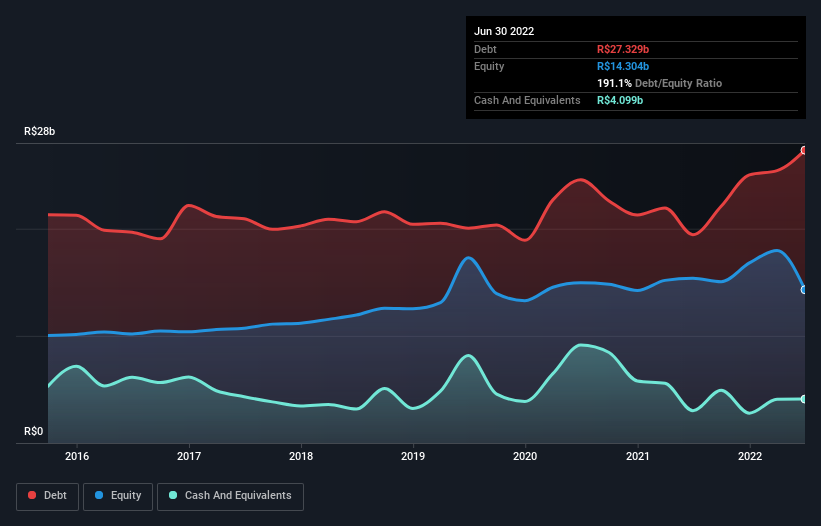- Brazil
- /
- Electric Utilities
- /
- BOVESPA:CPFE3
Here's Why CPFL Energia (BVMF:CPFE3) Can Manage Its Debt Responsibly

Howard Marks put it nicely when he said that, rather than worrying about share price volatility, 'The possibility of permanent loss is the risk I worry about... and every practical investor I know worries about.' So it seems the smart money knows that debt - which is usually involved in bankruptcies - is a very important factor, when you assess how risky a company is. As with many other companies CPFL Energia S.A. (BVMF:CPFE3) makes use of debt. But should shareholders be worried about its use of debt?
When Is Debt Dangerous?
Generally speaking, debt only becomes a real problem when a company can't easily pay it off, either by raising capital or with its own cash flow. Part and parcel of capitalism is the process of 'creative destruction' where failed businesses are mercilessly liquidated by their bankers. While that is not too common, we often do see indebted companies permanently diluting shareholders because lenders force them to raise capital at a distressed price. Of course, the upside of debt is that it often represents cheap capital, especially when it replaces dilution in a company with the ability to reinvest at high rates of return. The first thing to do when considering how much debt a business uses is to look at its cash and debt together.
See our latest analysis for CPFL Energia
What Is CPFL Energia's Debt?
The image below, which you can click on for greater detail, shows that at June 2022 CPFL Energia had debt of R$27.3b, up from R$19.4b in one year. However, because it has a cash reserve of R$4.10b, its net debt is less, at about R$23.2b.

A Look At CPFL Energia's Liabilities
The latest balance sheet data shows that CPFL Energia had liabilities of R$15.5b due within a year, and liabilities of R$36.1b falling due after that. On the other hand, it had cash of R$4.10b and R$7.83b worth of receivables due within a year. So it has liabilities totalling R$39.7b more than its cash and near-term receivables, combined.
This deficit is considerable relative to its market capitalization of R$41.6b, so it does suggest shareholders should keep an eye on CPFL Energia's use of debt. This suggests shareholders would be heavily diluted if the company needed to shore up its balance sheet in a hurry.
In order to size up a company's debt relative to its earnings, we calculate its net debt divided by its earnings before interest, tax, depreciation, and amortization (EBITDA) and its earnings before interest and tax (EBIT) divided by its interest expense (its interest cover). This way, we consider both the absolute quantum of the debt, as well as the interest rates paid on it.
CPFL Energia's net debt to EBITDA ratio of about 2.3 suggests only moderate use of debt. And its strong interest cover of 14.6 times, makes us even more comfortable. It is well worth noting that CPFL Energia's EBIT shot up like bamboo after rain, gaining 39% in the last twelve months. That'll make it easier to manage its debt. When analysing debt levels, the balance sheet is the obvious place to start. But ultimately the future profitability of the business will decide if CPFL Energia can strengthen its balance sheet over time. So if you want to see what the professionals think, you might find this free report on analyst profit forecasts to be interesting.
Finally, a business needs free cash flow to pay off debt; accounting profits just don't cut it. So the logical step is to look at the proportion of that EBIT that is matched by actual free cash flow. Looking at the most recent three years, CPFL Energia recorded free cash flow of 41% of its EBIT, which is weaker than we'd expect. That's not great, when it comes to paying down debt.
Our View
CPFL Energia's interest cover was a real positive on this analysis, as was its EBIT growth rate. On the other hand, its level of total liabilities makes us a little less comfortable about its debt. We would also note that Electric Utilities industry companies like CPFL Energia commonly do use debt without problems. When we consider all the elements mentioned above, it seems to us that CPFL Energia is managing its debt quite well. Having said that, the load is sufficiently heavy that we would recommend any shareholders keep a close eye on it. There's no doubt that we learn most about debt from the balance sheet. However, not all investment risk resides within the balance sheet - far from it. For example CPFL Energia has 3 warning signs (and 1 which makes us a bit uncomfortable) we think you should know about.
At the end of the day, it's often better to focus on companies that are free from net debt. You can access our special list of such companies (all with a track record of profit growth). It's free.
New: AI Stock Screener & Alerts
Our new AI Stock Screener scans the market every day to uncover opportunities.
• Dividend Powerhouses (3%+ Yield)
• Undervalued Small Caps with Insider Buying
• High growth Tech and AI Companies
Or build your own from over 50 metrics.
Have feedback on this article? Concerned about the content? Get in touch with us directly. Alternatively, email editorial-team (at) simplywallst.com.
This article by Simply Wall St is general in nature. We provide commentary based on historical data and analyst forecasts only using an unbiased methodology and our articles are not intended to be financial advice. It does not constitute a recommendation to buy or sell any stock, and does not take account of your objectives, or your financial situation. We aim to bring you long-term focused analysis driven by fundamental data. Note that our analysis may not factor in the latest price-sensitive company announcements or qualitative material. Simply Wall St has no position in any stocks mentioned.
About BOVESPA:CPFE3
CPFL Energia
Engages in the generation, transmission, distribution, and commercialization of electricity to residential, industrial, and commercial customers in Brazil.
Mediocre balance sheet and slightly overvalued.
Market Insights
Community Narratives


